About this Configuration Guide
This guide covers setting up the CoreLogic CLIP ID module integration template. Using this guide, you'll explore how the CoreLogic template works. You'll learn how to install the template to your environment and build an application from it. Plus, you'll see how to customize your application to fit your needs.
You need to set up your CoreLogic account directly through CoreLogic. When configuring your template, enter your CoreLogic credentials to grant your environment permission to use CoreLogic.
Here's a high-level overview of the modules:
Title | Element Type | Description |
|---|---|---|
Core Logic Property Search | Module | This module lets you dynamically add an address to locate its CoreLogic Integrated Property Number (CLIP) ID. The module then triggers the API module and displays the CLIP ID. |
CoreLogic Search Property (API) | Module | This API module uses the CoreLogic integration to dynamically populate a property's CLIP ID. |
CoreLogic | Service | CoreLogic provides real estate and property information and analytics. This service uses a unique CLIP ID for every address, which helps end-users find more information about a property. |
All images used in this guide are for illustrative purposes only. Images are subject to change without notice. All images are correct at the time of publication.
Overview
Primarily, this module uses CoreLogic to locate the unique CLIP ID for an address. It helps you find more information about a property in CoreLogic. This module also displays the APN Parcel Number if it's in the CoreLogic database.
This is a module integration template. So, let's say you build an application from this module. The template also adds a service (integration) to your environment in Services Administration. The service has a layout prepped for your CoreLogic credentials. You'll learn more about this later in the article.
Features
With this template, you can:
Look up and validate a company's address.
Locate a company's CLIP ID and APN Parcel Number.
Requirements
To use this template, you must have:
Administrator-level access to an Unqork environment.
An active CoreLogic account.
Adding the Template
Before you can build an application from this template, you must install the template to your environment. Then, you can visit your Library and build an application from your new template.
Adding the Template to Your Environment
To add the template to your environment:
Click Marketplace at the top right of the Unqork Designer Platform.
You can also access the Marketplace at any time by visiting https://marketplace.unqork.io.
Enter CoreLogic in the Search the Marketplace field.
Click the CoreLogic Integration tile.
Click Install to Environment.
Click Install Template.
If you aren't logged in, you see a field for Environment URL and a Login button. Enter your environment's URL where you want to install the template. For example: [environmentname.unqork.io]. Click the Login button. Then, return to step 4 and click Install to Environment again. Follow the remaining steps as listed.
Now, you can now use your newly installed template to create an application.
Creating an Application from the Template
After you add the template to your environment from Marketplace, you can use it to create an application. This template creates a module-type application.
Click Library at the top right of the Unqork Designer Platform.
Click Templates.
Find the CoreLogic template tile.
Click Create App from Template.
Choose the destination workspace from the Workspace drop-down. This is where your application lives once created.
Enter your unique App Name. The App Path auto-fills as you type your App Name.
If you want a different App Path, enter it in the App Path field.
Select a preview style from the Style drop-down. A style specifies your application’s appearance in Express View. If left blank, your application uses your environment's default style.
The App Type and App Entrypoint are grayed out. The template automatically takes care of these for you.
Click Create App.
The application opens in the workspace you specified. You land on the Modules tab of your application, which lists all modules of this template.
Your new application looks like this:

When you create an application from the template, your module names automatically include the template ID and a time stamp. This is to prevent any duplicate module paths. You can change module names and module paths at any time. Any service or workflow you create with your template also has a template ID and time stamp.
Here's an example of a CoreLogic service in Services Administration:
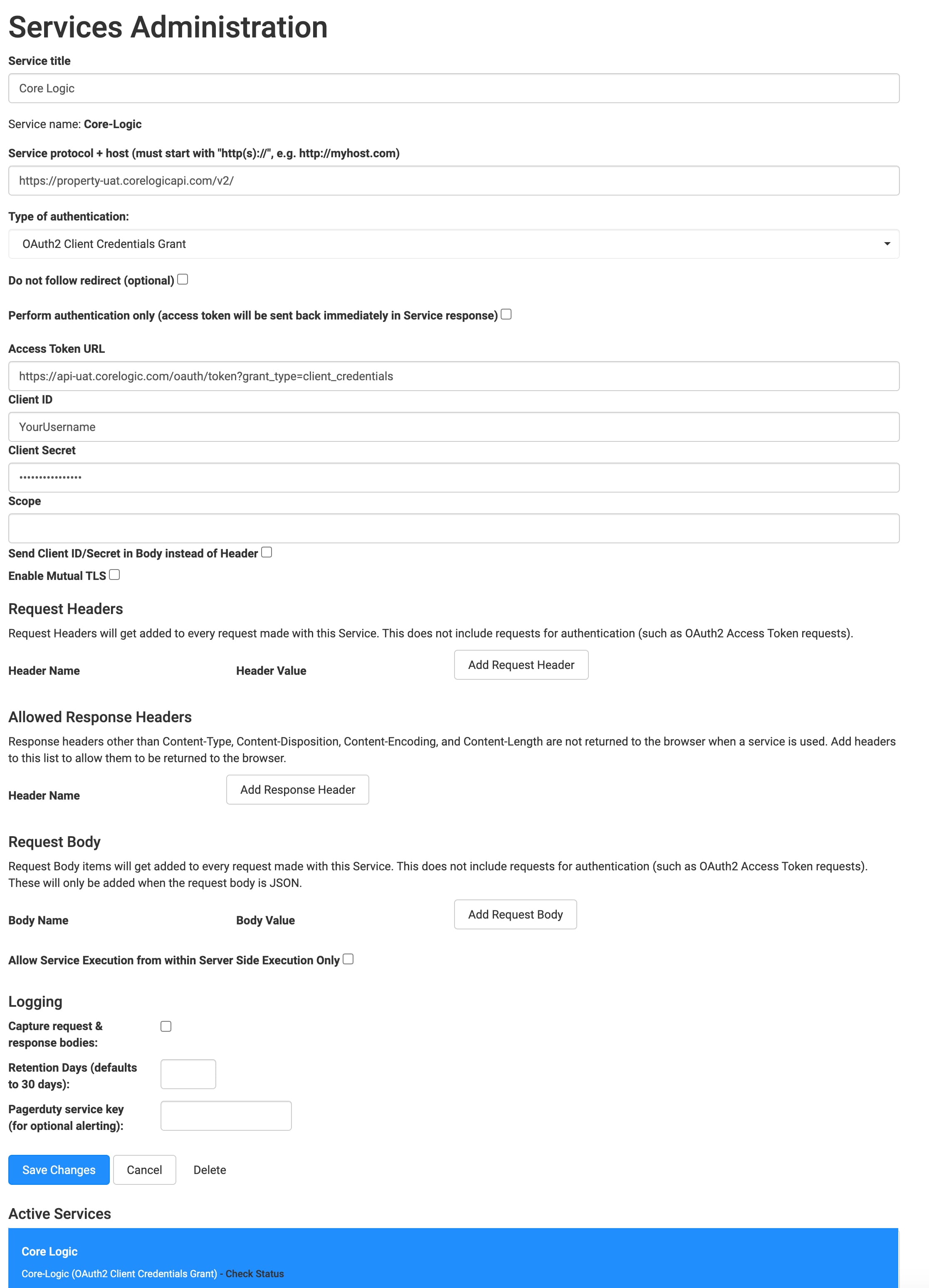
How the Template Works
As the name suggests, a module integration template has modules and an integration. An integration is a service external to Unqork. Here, the service is a CoreLogic API that takes an address an end-user enters, then displays a CLIP ID. You need to set up your CoreLogic account directly through CoreLogic. Your API keys generate automatically after creating your CoreLogic account.
How the CoreLogic Service Works
CoreLogic provides real estate and property information and analytics. Specifically, the CLIP ID is CoreLogic's standardized, digital identifier for each property. All information about a property lives in one place using its CLIP ID, and you can access it through this template.
But first, you need to look up the CLIP ID. Unqork uses an API call to pull CLIP IDs from the CoreLogic database. When you download this template, CoreLogic pulls data into your application through an API call. You can use the populated identification number to learn more about a property.
How the CoreLogic Property Search Module Works
The CoreLogic Property Search module is the only user-facing module in this template. So, it's the only one you or your end-user interacts with in Express View.
This module is where you fill out an address. You can either use the dynamic address field at the top of the page or fill in the information manually. If you have it, you can also enter the Access Point Number (APN) to further narrow your search. When you click Search, you see a CLIP ID and APN Parcel Number field.
This module always returns a CLIP ID, but not always an APN Parcel Number.
Here's how the module looks in the Module Builder:
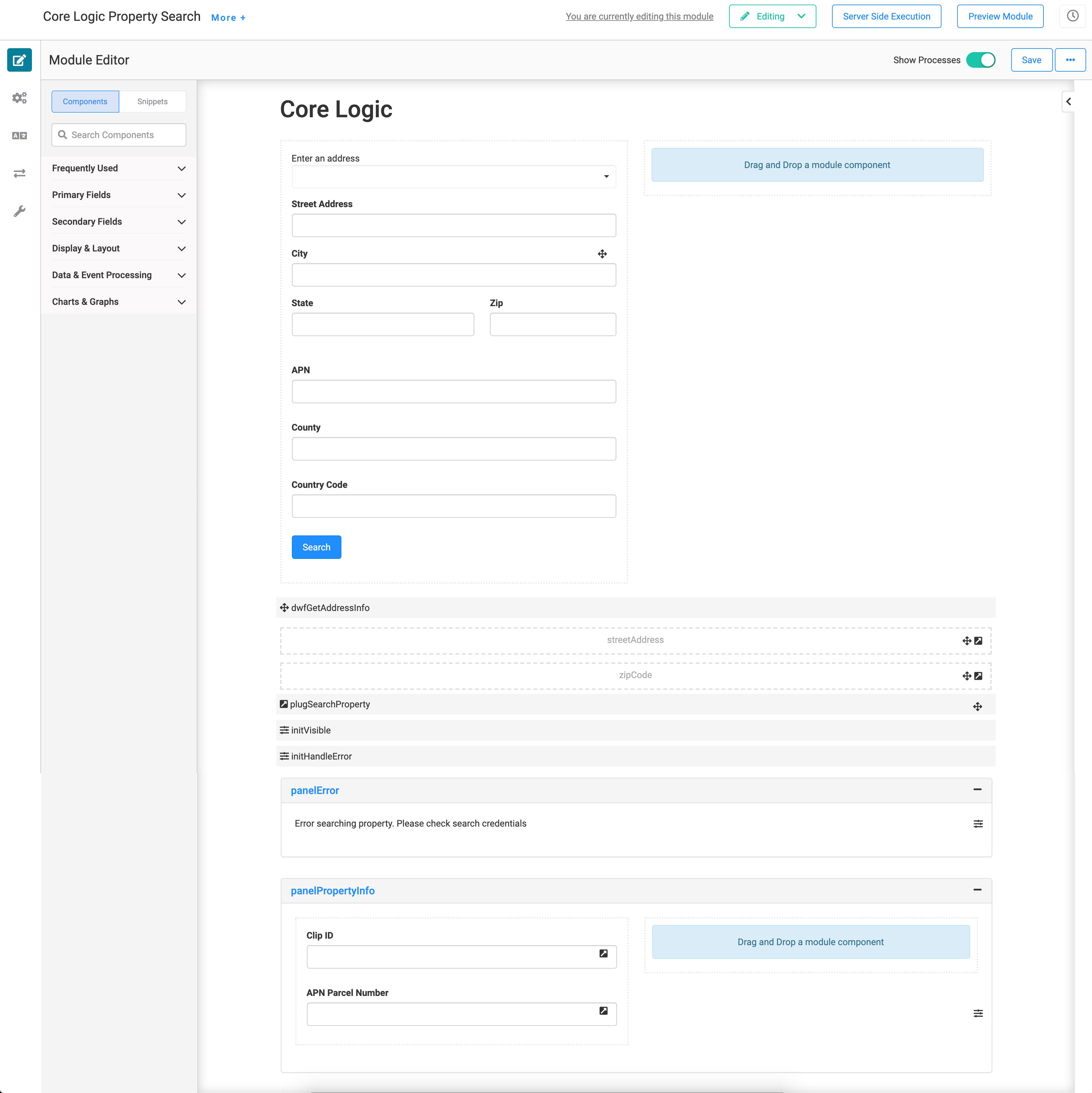
And here's how it works in Express View: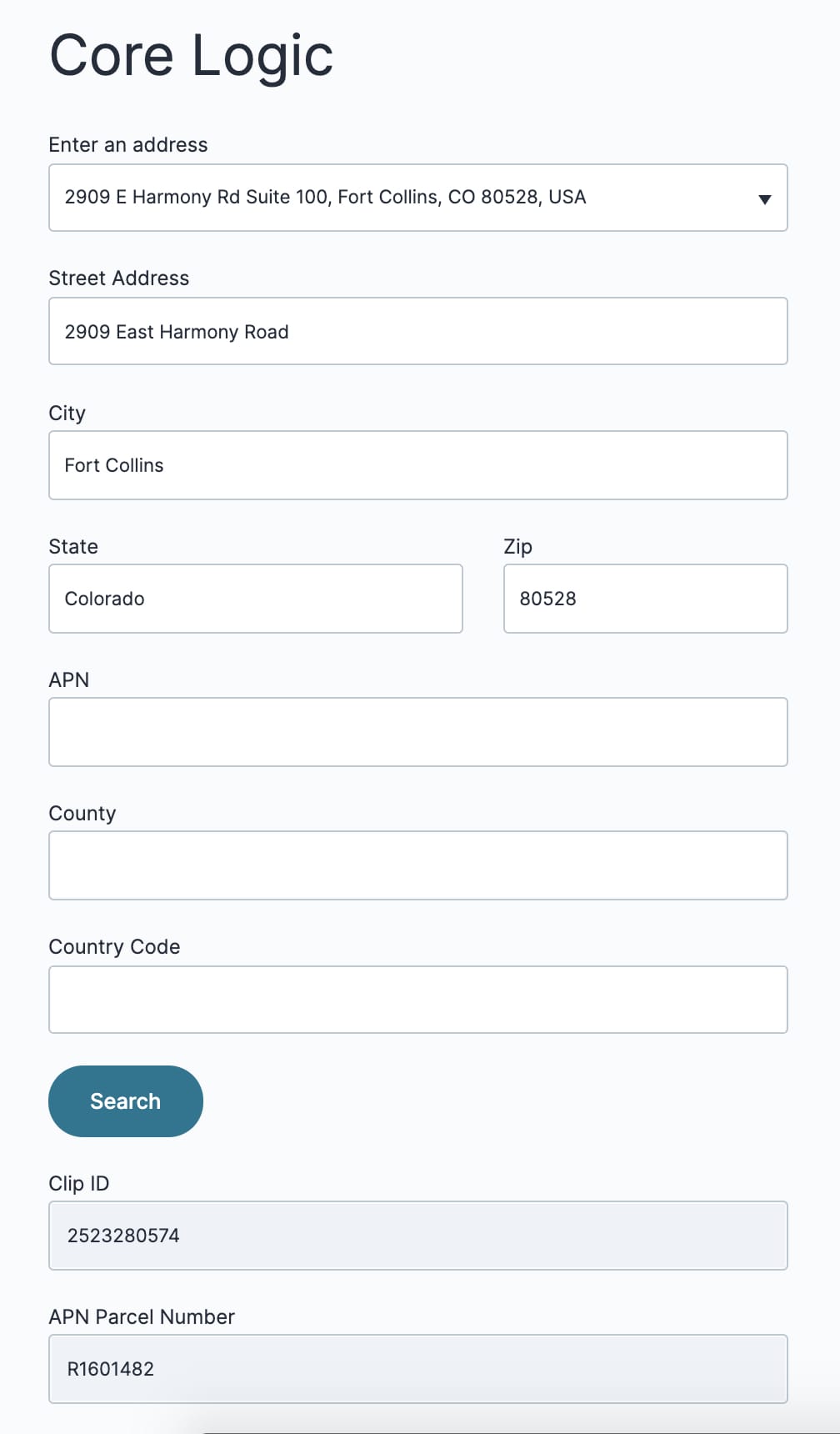
How the CoreLogic Integration (API) Module Works
The CoreLogic Integration (API) module does all the hard work for the template. After the end-user clicks Search in the previous module, the API module fires. It sends the full address to CoreLogic so it can pull the CLIP ID. If available, it also locates the APN Parcel Number. CoreLogic sends a response back to the CoreLogic Integration module. Then, the available identification numbers display at the bottom of the page.
Here's how the module looks in the Module Builder: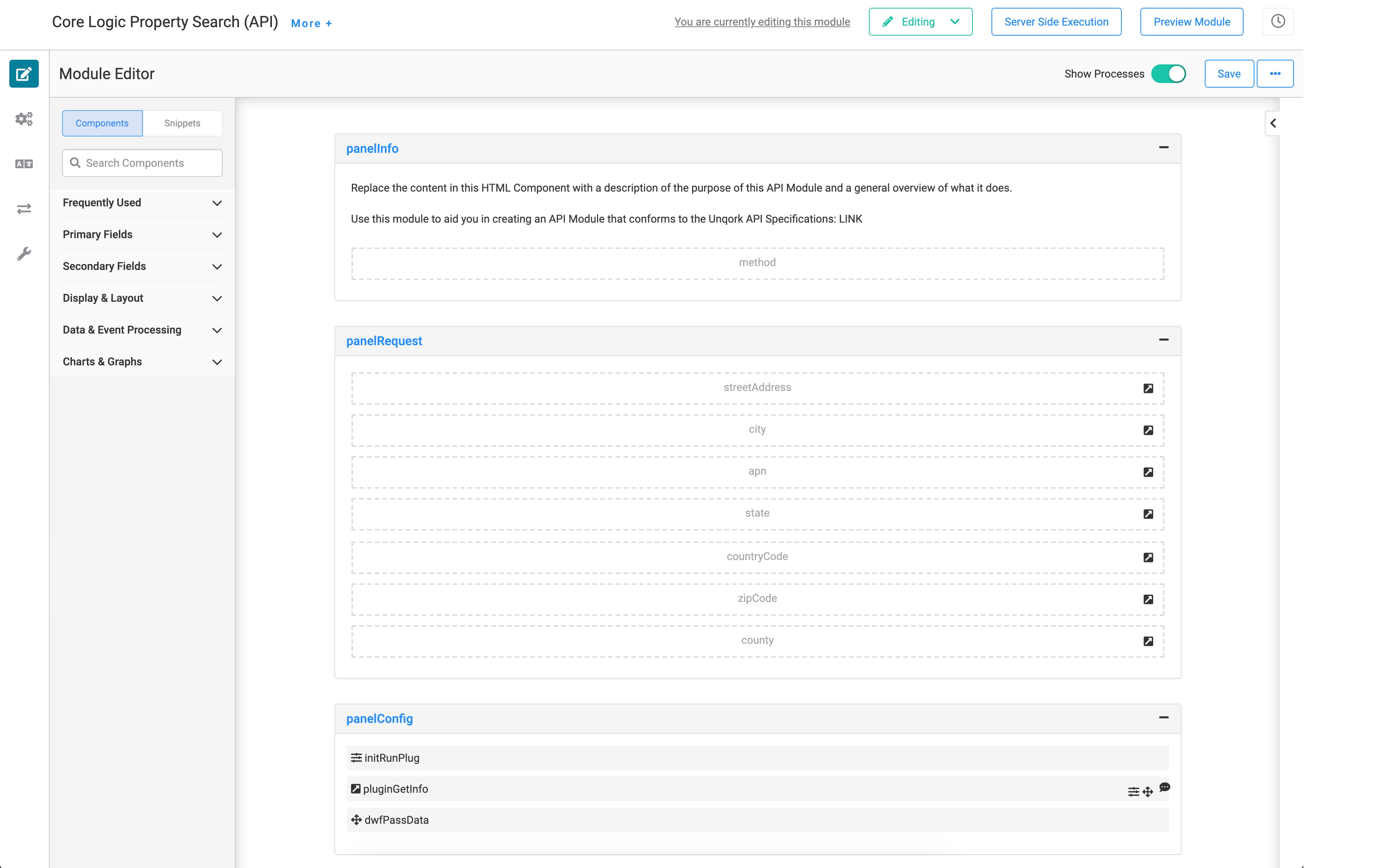
Configuring the Template
Once you create an application from this template, you need to update some configurations. To use the template, you need to update your CoreLogic service in Services Administration. You also need a CoreLogic Client ID (username) and Client Secret (password) to make the service work. Let's look at the configuration in more detail.
Configuring the CoreLogic Service in Services Administration
To access Services Administration:
Click the Settings drop-down at the top right of the Unqork Designer Platform.
Click Administration.
Under Integration, select Services Administration.
Next, you need to find and update the CoreLogic service with your CoreLogic Client ID and Secret:
Scroll to the bottom of your Active Services list.
Click your CoreLogic service.
What if your environment has more than one CoreLogic service? Look for the service with the same template ID and time stamp as the template's modules.
Scroll to the top of the page.
Enter your CoreLogic username in the Client ID field.
Enter your CoreLogic password in the Client Secret field.
When you open your CoreLogic service for the first time, you see there's already an obfuscated Client ID and Secret. This is a dummy entry, meaning it doesn't map anywhere. Make sure to enter your Bearer Token for this service to work. Note that once you save your Bearer Token to this CoreLogic service, it also becomes obfuscated.
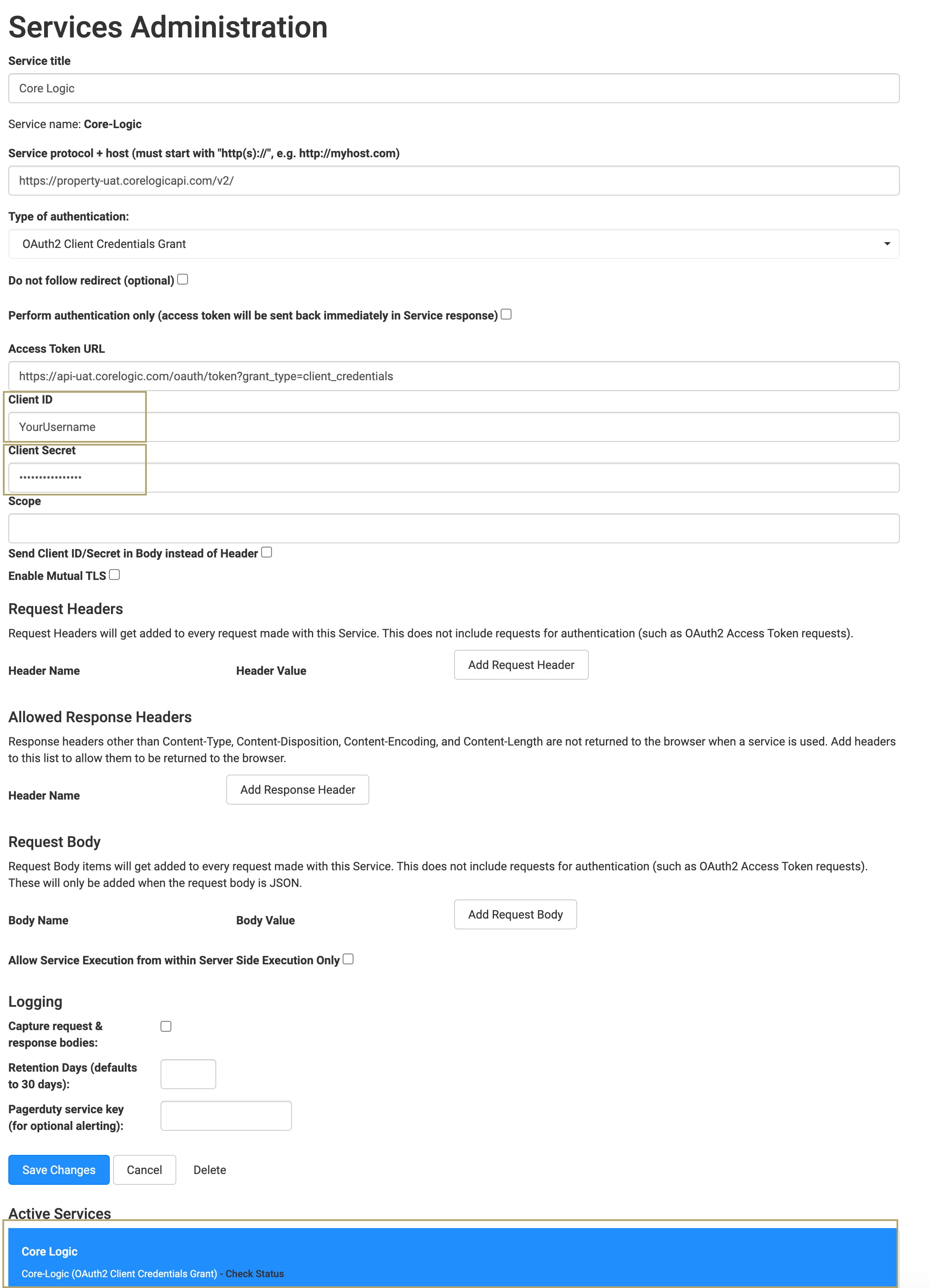
Click Save Changes.
Testing the Template
Now, let's test your template.
Open the CoreLogic POC module in Express View.
Enter an address in the Address field using either the dynamic address field or the manual address fields.
If you have it, enter the corresponding APN.
Click Search.
The API response object displays a CLIP ID. Try a few different addresses to make sure the APN Parcel Number also populates as expected.
Removing the Template
What if you no longer need this template or the application you built from it? There are multiple parts to removing this template.
Removing the Template from Your Environment
You might need to clean your environment and remove unused templates. The Unqork Library makes this easy. To uninstall a template from your environment:
At the top right of the Unqork Designer Platform, click Library.
Find the template to uninstall.
Click the ellipsis (...) in the template tile header.
Click Uninstall Template.
Click Yes, Uninstall in the confirmation modal.
You can visit the Marketplace and reinstall the template at any time.
What if you have an existing application built from this template and then uninstall the template from your environment? Your existing application remains unaffected. Also, it no longer has any ties to the template. So, let's say you reinstall a newer version of the template in the future. You can rest assured that the installation doesn't impact your existing application.
Deleting Your CoreLogic Application
If you no longer need the application you created from your template, you can delete it. To delete your application:
Navigate to the Apps tab from an open workspace.
Find the application to delete.
Click the ellipsis (...) in the app tile header.
Click Delete.
Retype the provided text.
Click Yes, Delete.
Removing the CoreLogic Service from Your Environment
To remove your service from your environment:
Click the Settings drop-down at the top right of the Unqork Designer Platform.
Click Administration.
Under Integration, select Services Administration.
Scroll down and select the CoreLogic service you want to delete from the Active Services list.
Click the Delete link. You’ll find this above the Active Services list.
At the Delete message, click OK.
At the Success message, click OK.